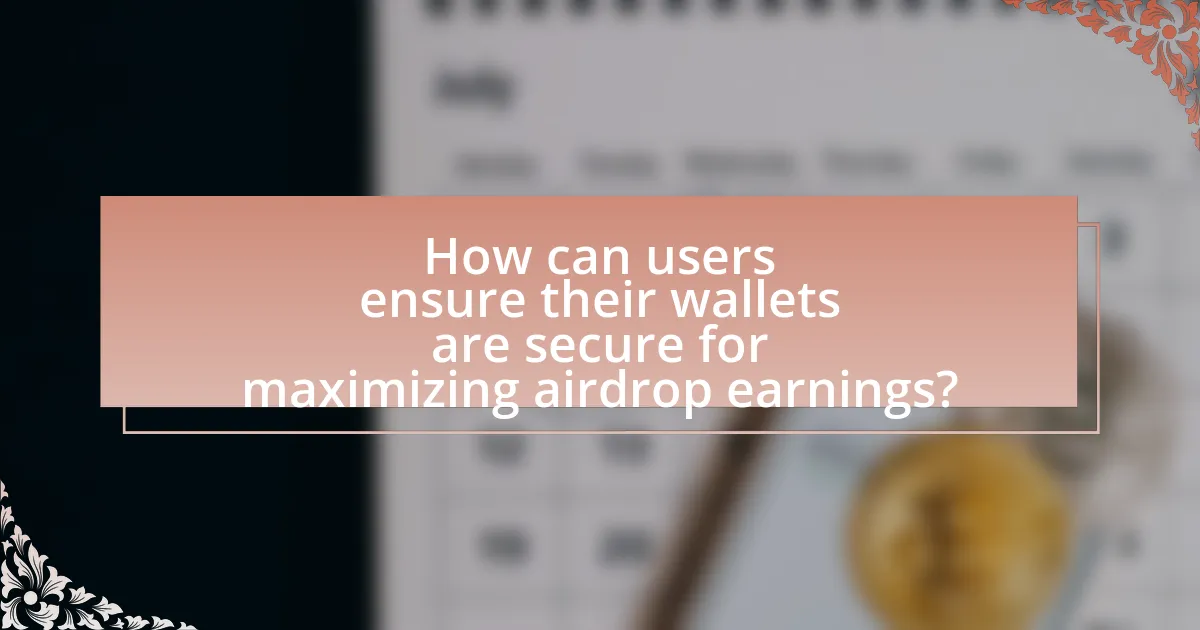The article focuses on essential wallet security features that are crucial for maximizing airdrop earnings in the cryptocurrency space. Key security measures discussed include two-factor authentication (2FA), private key management, and secure backup options, which collectively enhance wallet protection against unauthorized access and potential loss of funds. The article emphasizes the impact of robust security features on airdrop participation, highlighting how inadequate security can lead to missed opportunities and financial losses. Additionally, it outlines best practices for maintaining wallet security, such as using hardware wallets, regularly updating software, and avoiding common pitfalls like sharing sensitive information.

What are Essential Wallet Security Features for Maximizing Airdrop Earnings?
Essential wallet security features for maximizing airdrop earnings include two-factor authentication (2FA), private key management, and secure backup options. Two-factor authentication adds an extra layer of security by requiring a second form of verification, significantly reducing the risk of unauthorized access. Private key management ensures that users maintain control over their keys, as losing them can result in the loss of access to funds. Secure backup options, such as hardware wallets or encrypted cloud storage, protect against data loss and theft, ensuring that users can recover their wallets in case of device failure or compromise. These features collectively enhance wallet security, thereby maximizing the potential for earning from airdrops.
How do wallet security features impact airdrop earnings?
Wallet security features significantly impact airdrop earnings by protecting users from unauthorized access and potential loss of funds. Enhanced security measures, such as two-factor authentication, hardware wallets, and encryption, reduce the risk of hacking and phishing attacks, which can lead to the loss of airdropped tokens. For instance, a study by the Blockchain Security Alliance found that wallets with robust security protocols experienced 70% fewer successful hacking attempts compared to those with basic security. Therefore, implementing strong wallet security features directly correlates with increased airdrop earnings by safeguarding assets against theft and ensuring that users can claim and retain their airdropped tokens.
What specific security features should be prioritized for airdrop participation?
For airdrop participation, prioritizing two-factor authentication (2FA) and secure private key management is essential. Two-factor authentication significantly reduces the risk of unauthorized access by requiring a second form of verification, such as a code sent to a mobile device. Secure private key management ensures that users store their keys in a safe environment, such as hardware wallets, which are less susceptible to hacking compared to software wallets. According to a report by CipherTrace, 97% of cryptocurrency thefts occur due to poor key management practices, highlighting the importance of these security features in protecting assets during airdrop participation.
How can inadequate security features lead to loss of airdrop opportunities?
Inadequate security features can lead to loss of airdrop opportunities by making wallets vulnerable to hacks and unauthorized access. When wallets lack robust security measures such as two-factor authentication, encryption, or secure private key management, they become easy targets for cybercriminals. For instance, in 2020, a significant number of users lost access to their airdrop rewards due to phishing attacks that exploited weak security protocols. This highlights that without adequate security, users risk losing not only their airdrop opportunities but also their entire cryptocurrency holdings.
Why is wallet security crucial for cryptocurrency users?
Wallet security is crucial for cryptocurrency users because it protects their digital assets from theft and unauthorized access. Cryptocurrencies are stored in digital wallets, which can be vulnerable to hacking, phishing attacks, and malware. According to a report by Chainalysis, over $3.2 billion in cryptocurrency was stolen in 2020 alone, highlighting the significant risks associated with inadequate wallet security. Ensuring robust security measures, such as two-factor authentication and hardware wallets, can mitigate these risks and safeguard users’ investments.
What are the common threats to wallet security?
Common threats to wallet security include phishing attacks, malware, and unauthorized access. Phishing attacks trick users into revealing sensitive information, often through fake websites or emails, leading to compromised wallets. Malware can infect devices, allowing attackers to steal private keys or access wallet information. Unauthorized access occurs when individuals gain control over wallets through weak passwords or security vulnerabilities, resulting in potential loss of funds. According to a report by Cybersecurity Ventures, cybercrime is projected to cost the world $10.5 trillion annually by 2025, highlighting the increasing risks associated with wallet security.
How do these threats affect airdrop participation?
Threats such as phishing attacks, malware, and scams significantly reduce airdrop participation by instilling fear and distrust among potential participants. When individuals perceive a high risk of losing their assets or personal information, they are less likely to engage in airdrop opportunities. For instance, a report from the Federal Trade Commission indicated that consumers lost over $1.4 billion to fraud in 2021, highlighting the impact of scams on user behavior. Consequently, the prevalence of these threats leads to decreased engagement in airdrops, as users prioritize security over potential earnings.

What are the key security features to look for in a cryptocurrency wallet?
The key security features to look for in a cryptocurrency wallet include private key control, two-factor authentication (2FA), encryption, and backup options. Private key control ensures that users have sole access to their funds, reducing the risk of theft. Two-factor authentication adds an extra layer of security by requiring a second form of verification, making unauthorized access more difficult. Encryption protects sensitive data from being accessed by malicious actors, while backup options allow users to recover their wallets in case of loss or damage. These features collectively enhance the security of cryptocurrency wallets, safeguarding users’ assets against potential threats.
What role does two-factor authentication play in wallet security?
Two-factor authentication (2FA) significantly enhances wallet security by requiring two forms of verification before granting access. This additional layer of security mitigates the risk of unauthorized access, as even if a password is compromised, the second factor—often a temporary code sent to a mobile device—remains secure. According to a study by Google, implementing 2FA can block 99.9% of automated attacks, demonstrating its effectiveness in protecting sensitive information and assets within digital wallets.
How does two-factor authentication enhance protection against unauthorized access?
Two-factor authentication (2FA) enhances protection against unauthorized access by requiring users to provide two distinct forms of identification before gaining access to their accounts. This method significantly reduces the risk of unauthorized access because even if a malicious actor obtains a user’s password, they would still need the second factor, typically a code sent to the user’s mobile device or generated by an authentication app, to successfully log in. According to a study by Google, implementing 2FA can block 100% of automated bots and 96% of phishing attacks, demonstrating its effectiveness in safeguarding sensitive information and accounts.
What are the best practices for implementing two-factor authentication?
The best practices for implementing two-factor authentication (2FA) include using a combination of something you know (like a password) and something you have (like a mobile device). This dual-layer security significantly reduces the risk of unauthorized access.
To enhance security, it is advisable to utilize time-based one-time passwords (TOTP) generated by authenticator apps, as they are more secure than SMS-based codes, which can be intercepted. Additionally, enforcing 2FA for all user accounts, especially those with access to sensitive information, is crucial. Regularly updating authentication methods and educating users about phishing attacks further strengthens the security framework.
According to a study by Google, implementing 2FA can block 100% of automated bots and 96% of targeted attacks, demonstrating its effectiveness in safeguarding accounts.
How does encryption contribute to wallet security?
Encryption significantly enhances wallet security by converting sensitive data into a coded format that is unreadable without a decryption key. This process protects private keys and transaction information from unauthorized access, ensuring that only the wallet owner can access their funds. For instance, wallets that utilize strong encryption algorithms, such as AES (Advanced Encryption Standard), provide a robust defense against hacking attempts, as these algorithms are designed to withstand brute-force attacks. Additionally, encryption helps maintain the integrity of transactions by preventing tampering, thereby safeguarding users’ assets during transfers.
What types of encryption are most effective for cryptocurrency wallets?
The most effective types of encryption for cryptocurrency wallets are asymmetric encryption and symmetric encryption. Asymmetric encryption, such as RSA or ECC (Elliptic Curve Cryptography), allows users to generate a public-private key pair, enhancing security by ensuring that only the holder of the private key can access the wallet. Symmetric encryption, like AES (Advanced Encryption Standard), provides robust data protection by using the same key for both encryption and decryption, making it suitable for encrypting wallet files and sensitive information. These encryption methods are widely recognized for their effectiveness in safeguarding digital assets against unauthorized access and theft.
How can users verify the encryption standards of their wallets?
Users can verify the encryption standards of their wallets by checking the wallet’s documentation and security features provided by the developers. Most reputable wallet providers publish detailed information about their encryption methods, including the types of algorithms used, such as AES-256 or RSA, and whether they implement additional security measures like two-factor authentication. For example, a wallet that uses AES-256 encryption is widely recognized as secure, as this standard is commonly used in the industry for protecting sensitive data. Additionally, users can look for third-party security audits or certifications that validate the wallet’s encryption practices, ensuring that the wallet meets established security benchmarks.

How can users ensure their wallets are secure for maximizing airdrop earnings?
Users can ensure their wallets are secure for maximizing airdrop earnings by implementing strong security measures such as enabling two-factor authentication (2FA), using hardware wallets, and regularly updating wallet software. Two-factor authentication adds an extra layer of security by requiring a second form of verification, significantly reducing the risk of unauthorized access. Hardware wallets, which store private keys offline, protect against online threats and hacking attempts, making them a safer option for holding cryptocurrencies. Regularly updating wallet software ensures that users benefit from the latest security patches and features, further safeguarding their assets. These practices collectively enhance wallet security, thereby maximizing potential airdrop earnings.
What are the best practices for maintaining wallet security?
The best practices for maintaining wallet security include using strong, unique passwords, enabling two-factor authentication, and regularly updating wallet software. Strong passwords should consist of a mix of letters, numbers, and symbols, making them difficult to guess. Two-factor authentication adds an extra layer of security by requiring a second form of verification, such as a text message or authentication app. Regularly updating wallet software ensures that users benefit from the latest security patches and features, reducing vulnerabilities. According to a report by the Cybersecurity & Infrastructure Security Agency, 80% of data breaches involve weak or stolen passwords, highlighting the importance of these practices in safeguarding digital assets.
How often should users update their wallet software?
Users should update their wallet software regularly, ideally every time a new version is released. Regular updates are crucial for maintaining security, as they often include patches for vulnerabilities and enhancements to protect against emerging threats. For instance, a report by the Cybersecurity and Infrastructure Security Agency (CISA) indicates that outdated software is a common target for cyberattacks, emphasizing the importance of timely updates to safeguard digital assets.
What steps can users take to secure their private keys?
Users can secure their private keys by implementing several key practices. First, they should use hardware wallets, which store private keys offline and are less vulnerable to hacking. Additionally, users must enable two-factor authentication (2FA) on their wallets to add an extra layer of security. Regularly updating wallet software is crucial, as updates often include security patches that protect against vulnerabilities. Users should also create strong, unique passwords for their wallets and avoid sharing them. Finally, backing up private keys in a secure location, such as a safe or encrypted digital storage, ensures recovery in case of loss. These steps collectively enhance the security of private keys, reducing the risk of unauthorized access and potential loss of assets.
What common mistakes should users avoid to protect their airdrop earnings?
Users should avoid sharing private keys and sensitive information to protect their airdrop earnings. Sharing private keys can lead to unauthorized access to wallets, resulting in the loss of funds. Additionally, users should refrain from participating in airdrops that require excessive personal information, as this can expose them to phishing attacks. Using unsecured networks for transactions can also compromise wallet security, making it essential to utilize secure connections. Lastly, neglecting to enable two-factor authentication can leave accounts vulnerable to hacking attempts. These practices are crucial for safeguarding airdrop earnings against common threats in the cryptocurrency space.
How can phishing attacks compromise wallet security?
Phishing attacks can compromise wallet security by tricking users into revealing their private keys or recovery phrases. Attackers often use deceptive emails, websites, or messages that mimic legitimate services to lure individuals into entering sensitive information. For instance, a report by the Anti-Phishing Working Group indicated that in 2021, phishing attacks targeting cryptocurrency wallets increased significantly, with over 7,000 incidents reported, highlighting the vulnerability of users to such tactics. When users unknowingly provide their credentials, attackers gain unauthorized access to their wallets, leading to potential loss of funds.
What are the signs of a potential security breach in a wallet?
Signs of a potential security breach in a wallet include unauthorized transactions, unexpected changes in account settings, and alerts from security software. Unauthorized transactions indicate that someone may have accessed the wallet without permission, while unexpected changes, such as altered recovery phrases or contact information, suggest tampering. Alerts from security software can signal suspicious activity or malware presence. According to a report by the Cybersecurity and Infrastructure Security Agency, 60% of breaches involve compromised credentials, emphasizing the importance of monitoring wallet activity closely.
What practical tips can enhance wallet security for airdrop participation?
To enhance wallet security for airdrop participation, users should implement multi-factor authentication (MFA) on their wallets. MFA adds an extra layer of security by requiring not only a password but also a second form of verification, such as a text message or authentication app code. This significantly reduces the risk of unauthorized access, as even if a password is compromised, the attacker would still need the second factor to gain entry. Additionally, users should regularly update their wallet software to protect against vulnerabilities, as updates often include security patches. According to a report by the Cybersecurity and Infrastructure Security Agency, keeping software up to date is one of the most effective ways to defend against cyber threats. Furthermore, users should avoid sharing sensitive information or private keys and be cautious of phishing attempts, as these are common tactics used by attackers to compromise wallets.


